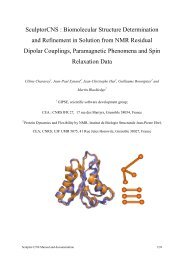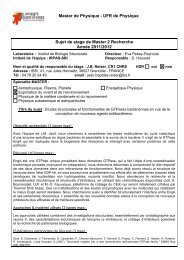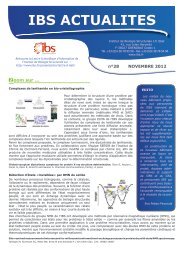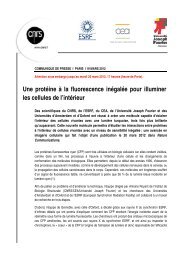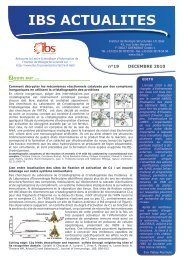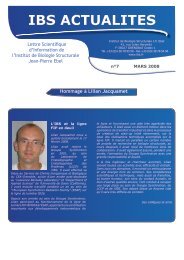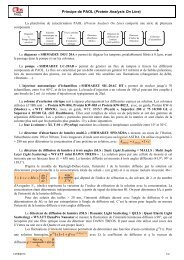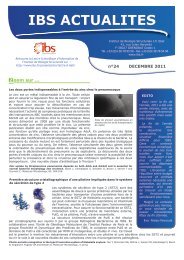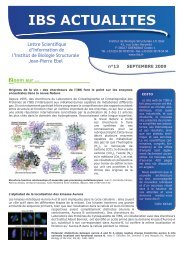OMPX Mathilde Lethier , Martine Moulin , Michae - Institut de ...
OMPX Mathilde Lethier , Martine Moulin , Michae - Institut de ...
OMPX Mathilde Lethier , Martine Moulin , Michae - Institut de ...
Create successful ePaper yourself
Turn your PDF publications into a flip-book with our unique Google optimized e-Paper software.
RESULTS<br />
We <strong>de</strong>scribe here a protocol for obtaining <strong>de</strong>uterated at OmpX in large amounts. OmpX is<br />
known from X-Ray and NMR studies (Pautsch et al. 1999; Vogt and Shultz 1999; Fernan<strong>de</strong>z<br />
et al., 2004, Catoire et al. 2010). OmpX relatively easily obtained in hydrogenated and<br />
<strong>de</strong>uterated forms (see in the references above). The protocol presented here reports the<br />
modifications to known protocols,nee<strong>de</strong>d to carry out high cell <strong>de</strong>nsity fermention at the ILL-<br />
EMBL Deuteration Facility (Grenoble, France). The aim is to obtain large amounts. Full<br />
<strong>de</strong>uteration is not required: the required level of <strong>de</strong>uteration is ≈ 75% to match-out OmpX in<br />
100% D 2 O. We have also introduced a His-Tag on the protein for facilitating surfactant<br />
exchange procedure.<br />
Our results show:<br />
1: Cell lysis and solubilisation of the inclusion body is tricky with the high <strong>de</strong>nsity<br />
culture in <strong>de</strong>uterated minimum media.<br />
2 : Introducing a His Tag confers new folding properties: refolding of the protein from<br />
inclusion bodies has to be optimised for new construct.<br />
3: Refolding rate is the same for hydrogenated and <strong>de</strong>uterated forms.<br />
4 : An aggregation propensity is noted for the construct bearing a His-Tag after elution<br />
from NiNTA affinity columns.<br />
Step 1: Modification of the plasmid of OmpX for high <strong>de</strong>nsity cell culture.<br />
• The plasmid encoding OmpX was a gift from Laurent Catoire (IBPC), who obtained it from<br />
G.E. Schultz (Germany). The gene lacks the sequence coding for the signal pepti<strong>de</strong>. The<br />
truncated gene was inserted into the ampicillin resistant vector pET3b, between the N<strong>de</strong>I<br />
and BamHI restriction sites.<br />
• Since the requirement for over-expression in D 2 O in the Dlab fermentors is a kanamycinresistant<br />
vector, we cloned OmpX into pETM11, between the NcoI and BamHI restriction<br />
sites. The vector provi<strong>de</strong>s also a poly-histidine-tag at the N-terminal position of OmpX. The<br />
His-tag can be eventually removed with the TEV protease. After E. coli BL21 (DE3) strain<br />
transformation, the expression and purification of OmpX in hydrogenated LB medium was<br />
tested, but unfortunately, the protein could not be refol<strong>de</strong>d efficiently (data not shown),<br />
most probably because of the presence of the His-tag at the N-ter position.<br />
• We thus cloned OmpX into pET24a+ plasmid, between the XhoI and N<strong>de</strong>I restriction sites,<br />
this second construction providing a poly-histidine-tag at the C-terminal position of OmpX.<br />
A single mutation H100N, which was <strong>de</strong>scribed to favour protein crystallisation (Pautsch et<br />
al., 1999), was ad<strong>de</strong>d by site-directed mutagenesis. In the following, OmpX and, for the<br />
<strong>de</strong>uterated form, D-OmpX, correspond to proteins from this construct.<br />
Step 2: Purification of hydrogenated OmpX.<br />
E. coli BL21 DE3 strain was transformed, and OmpX was over-expressed in inclusion bodies.<br />
After cell breakage, they were recovered and washed by centrifugation as <strong>de</strong>scribed in<br />
(Pautch et al., 1999). As minor modifications, 1: the buffer for re-suspension of the bacterial<br />
cells (20 mM Tris pH 8.5) contained DNase I (250 U) and a cocktail tablet of anti-protease<br />
(one tablet /50mL solution) from Roche whereas EDTA was removed. 2: a microfluidizer<br />
apparatus (Microfluidics M-110P) was used to break the cell instead of sonication. Inclusion<br />
bodies solubilisation and refolding steps were performed similarly to (Pautch et al., 1999).<br />
However, the His-tagged OmpX refolding in 5% C8POE, was much lower when compared to<br />
the protein without His-tag. The yield was ~50% instead of 90-100%.<br />
2



